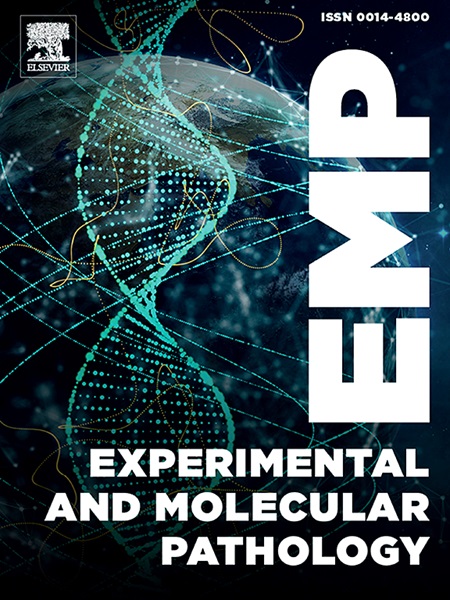腺嘌呤诱导大鼠少弱精子症模型HPT轴转录组学分析。
IF 3.7
4区 医学
Q2 PATHOLOGY
引用次数: 0
摘要
男性不育症最常见的原因是少精子症,而人们对其发病机制的分子水平还知之甚少。本研究利用 RNA 测序(RNA-Seq)技术,在健康大鼠和腺嘌呤诱导的少精子症模型大鼠的下丘脑、垂体和睾丸组织中鉴定调控精液质量的候选基因和调控通路。我们对两组大鼠的精液质量进行了检测,并对睾丸组织进行了组织学分析。我们在下丘脑、垂体和睾丸中分别发现了 627、692 和 437 个差异表达基因。功能分析表明,"神经元投射"、"激素生物合成过程的正向调节 "和 "神经活性配体-受体相互作用途径 "与下丘脑-垂体-睾丸(HPT)轴激素调节和精子生成密切相关。七个基因(Pomc、Rxfp1、Tac1、Npy、Insl3、Hsd3b3、Lhcgr)被确定为负责调节 HPT 轴内精子质量的关键候选基因,可能通过影响睾丸发育和睾酮分泌来影响大鼠的生殖功能。这些数据为进一步了解少精症大鼠模型中生殖功能的分子机制提供了理论基础。本文章由计算机程序翻译,如有差异,请以英文原文为准。

Transcriptomic analysis of the HPT axis in a model of oligoasthenozoospermia induced by Adenine in rats
Male infertility is most commonly caused by oligozoospermia, and its pathogenesis is still poorly understood at the molecular level. This study used RNA sequencing (RNA-Seq) technology to identify candidate genes and regulatory pathways that regulate semen quality in the hypothalamic, pituitary, and testicular tissues of healthy rats and Adenine-induced oligozoospermia model rats. Semen quality testing and histological analysis of testicular tissues were performed on both groups of rats. We identified 627, 692, and 437 differentially expressed genes in the hypothalamus, pituitary gland, and testes, respectively. Functional analysis indicates that “neuronal projections,” “positive regulation of hormone biosynthetic process,” and “neuroactive ligand-receptor interaction pathways” are closely related to the hypothalamic-pituitary-testicular (HPT) axis hormone regulation and sperm production. Seven genes (Pomc, Rxfp1, Tac1, Npy, Insl3, Hsd3b3, Lhcgr) have been identified as key candidate genes responsible for regulating sperm quality within the HPT axis, potentially affecting rat reproductive function by influencing testicular development and testosterone secretion. These data provide a theoretical basis for further understanding the molecular mechanisms of reproductive performance in a rat model of oligoasthenozoospermia.
求助全文
通过发布文献求助,成功后即可免费获取论文全文。
去求助
来源期刊
CiteScore
8.90
自引率
0.00%
发文量
78
审稿时长
11.5 weeks
期刊介绍:
Under new editorial leadership, Experimental and Molecular Pathology presents original articles on disease processes in relation to structural and biochemical alterations in mammalian tissues and fluids and on the application of newer techniques of molecular biology to problems of pathology in humans and other animals. The journal also publishes selected interpretive synthesis reviews by bench level investigators working at the "cutting edge" of contemporary research in pathology. In addition, special thematic issues present original research reports that unravel some of Nature''s most jealously guarded secrets on the pathologic basis of disease.
Research Areas include: Stem cells; Neoangiogenesis; Molecular diagnostics; Polymerase chain reaction; In situ hybridization; DNA sequencing; Cell receptors; Carcinogenesis; Pathobiology of neoplasia; Complex infectious diseases; Transplantation; Cytokines; Flow cytomeric analysis; Inflammation; Cellular injury; Immunology and hypersensitivity; Athersclerosis.

 求助内容:
求助内容: 应助结果提醒方式:
应助结果提醒方式:


